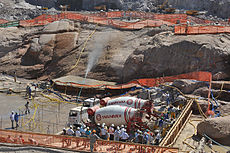Programa de Aceleração do Crescimento
The Programa de Aceleração do Crescimento (Growth Acceleration Program), better known as PAC, is a major infrastructure program of the Federal government of Brazil. The program was launched on January 28, 2007, by the Lula da Silva administration, consisting of a set of economic policies and investment projects with the objective of accelerating economic growth in Brazil. The program had a budget of $503.9 billion reais for the 2007-2010 quadriennium. The Rousseff administration has continued the program under the name PAC-2.
Program structure[]

The Growth Acceleration Program forecasts investments by the Federal government, state enterprises and the private sector in construction, sanitation, energy, transport and logistics. The program had an estimated budget of $503.9 billion reais for the 2007–2010 quadriennium.[1]
PAC 2[]
PAC 2[2] was launched in March 2010 by President Dilma Rouseff. It was set up as a continuation of the original PAC, which was designed to last only four years. PAC 2 had a budget of R$1.59 trillion, and focused on the development of social and infrastructure sectors such as transportation, energy, health care, culture, and housing.
See also[]
References[]
- ^ Com PAC, governo espera investimento de R$ 504 bi até 2010 Folha de S.Paulo. Retrieved on 2012-03-29. (in Portuguese).
- ^ "Qual a diferença entre PAC1 e PAC2? — Ministério do Planejamento, Desenvolvimento e Gestão". www.planejamento.gov.br (in Portuguese). Retrieved 2017-05-17.
External links[]
- Official website (in Portuguese)
- Public finance of Brazil
- Government agencies of Brazil
- Luiz Inácio Lula da Silva
- Brazil government stubs